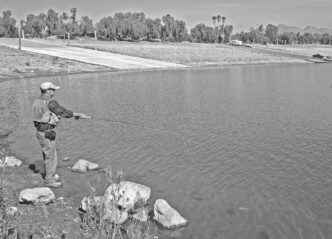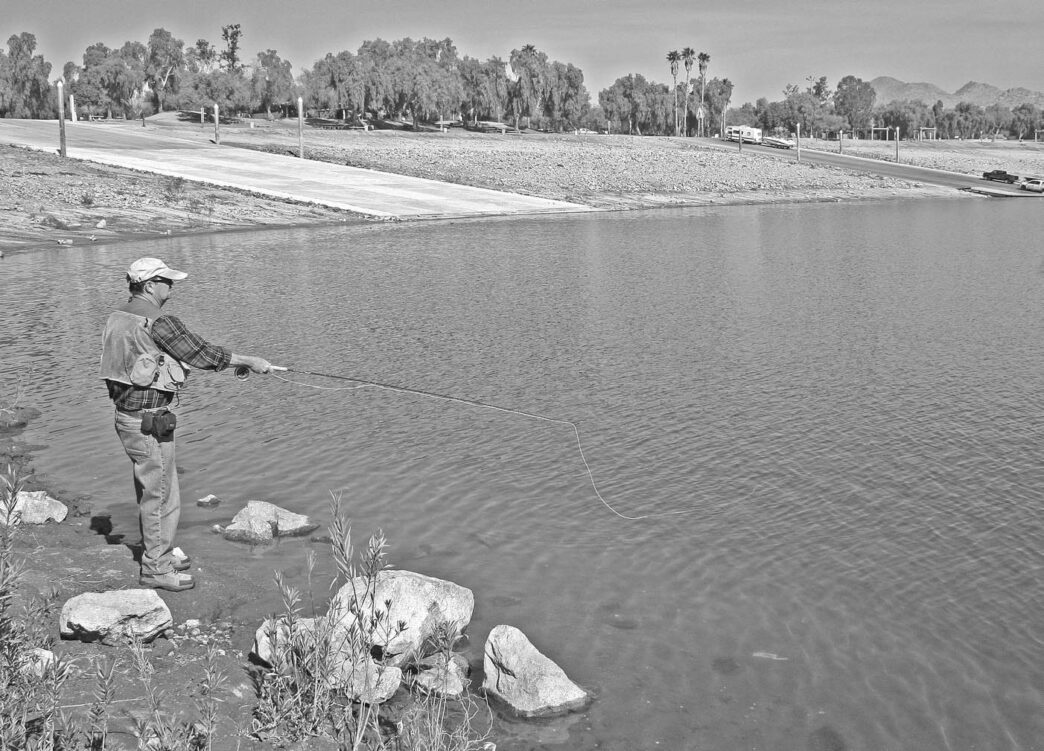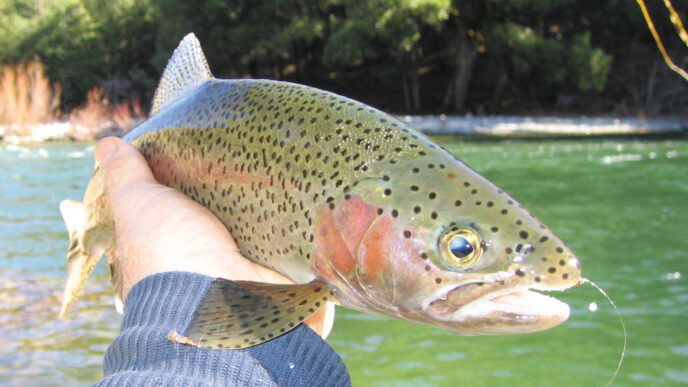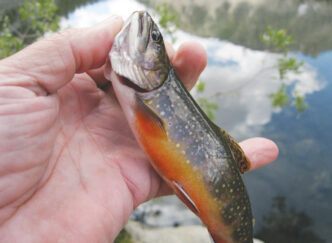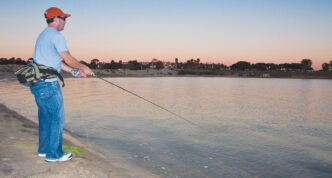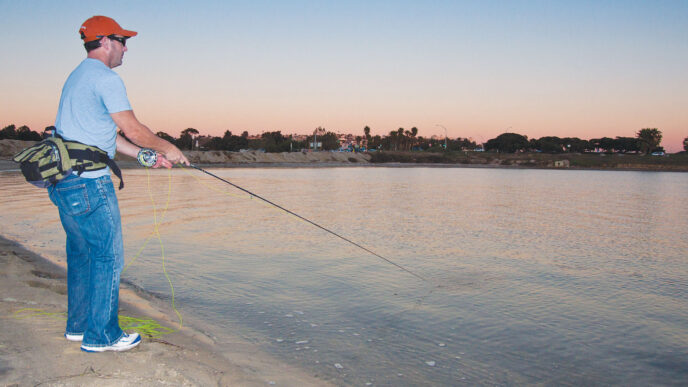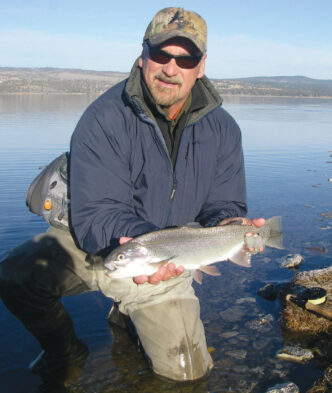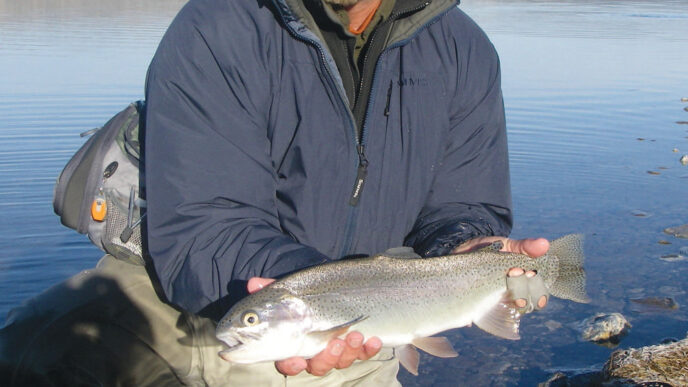Some of the best bass angling in the Inland Empire of Southern California can be found at Diamond Valley Lake. The drawback to that otherwise magnificent fishery, however, is that it offers only limited access. Float tubes aren’t allowed, so you must either bring your own boat or rent one. This takes planning and cash. Wading is likewise against the rules, and not much of the shoreline is suitable for fly fishing. All in all, while Diamond Valley is a great bass fishery for conventional-tackle types, it is not necessarily the best choice for anyone who wants to use fly gear.
On the other hand, just up the road an hour away is a equally excellent bass lake that is open most of each week now and that will be open seven days a week starting in May. This lake offers easy access all around its perimeter. As a matter of fact, its managers don’t even charge a launch fee for float tubes, canoes, or kayaks.
Lake Perris, in Moreno Valley, is an ideal winter/spring fishery, and at just under 1,600 feet in altitude, it enjoys a mild climate most of the year. Spring, which begins for the bass in late February, is a great time to locate and catch trophy-sized largemouths. Florida-strain and Floridanorthern hybrids dominate the fishery. There are also fantastic bluegill and redear sunfish populations, and in the last couple of years, crappies have been caught in fair numbers. In addition, trout are stocked all winter long — and holdover fish remain available through the summer for fly fishers who use lead-core line to troll streamers in a few specific locations (but that’s another story).
With all that going on, why is Lake Perris not at the top of every fly fisher’s list? Three years ago, it was discovered that a previously unknown earthquake fault ran close to the rock-and-earth dam that forms the lake’s southwest side. State engineers decided that drawing the lake down would take pressure off the dam, providing safety against an earthquake and also ensuring that the lake needn’t be closed to the public.
The drawdown was nearly 27 vertical feet, which put much of the lake’s better spawning areas out of the water, but otherwise changed the lake only a modest amount. You can get a good look at what Lake Perris looks like now on Google Earth. You can also click on a time tool at the top of the display and run back a few years to see the difference. It’s less than you might expect.
Unfortunately, the public thought the lowering of the water level would ruin the fishing, and once an idea gets stuck in people’s minds, it tends to stay there. What actually happened was that the fishing stayed at near the old level of activity, with visitors enjoying very good angling.
A Bit of History
Lake Perris is one of a number of California State Recreation Areas scattered about the Southland. Perris opened for recreation and angling in 1974. I was there, and the trout fishing that first spring was exceptional. The lake was full of two-to-three-pound rainbows. It was also selected by the California Department of Fish and Game for an experiment in establishing a fishery for the Alabama spotted bass, a subspecies that shares some physical features of both largemouth and smallmouth bass. The DFG decided on Lake Perris because it was a new lake with no predators bigger than the spotted bass, and since there were no other bass, there was no danger of hybridization.
The experiment worked well. Ninety-five spotted bass brought from Alabama spawned quickly, and in a few years, anglers were getting good results on spots from three to five pounds, and there was every reason to believe that Perris would produce even better results. These began to occur by the late 1970s. A nine-pound, two-ounce spot (larger than the then-current world record of eight pounds, ten ounces, but not submitted) was caught in 1979. In 1984, a nine-pound, one-ounce football-shaped spot was caught for a new state and International Game Fish Association world record. Then, in 1987, angling for spotted bass at Perris again exploded with a flurry of giant fish, including a double world record for the species, at nine pounds, four ounces, co-held by Gil Rowe and Steve West of Southern California.
By the late 1980s, however, it was as common to catch illegally introduced largemouths as it was spotted bass. In some parts of the lake, notably on the brushy, shallow east and north sides, the largemouths made better use of the habitat and outnumbered the spots. The overwhelming majority of the bass these days are Florida-strain largemouths. A recent sampling by DFG biologists showed no spotted bass among 200 largemouths captured and released.
Today’s Fishery
Lake Perris might just be a big bowl full of water controlled by the Metropolitan Water District, but it is part of the California State Park system and is managed for recreation — including fly fishing. Roughly triangular in shape, it offers a variety of structure and shoreline cover that holds bass, bluegills, redear sunfish, crappies, and trout.
The dam on the southwest side of the lake is 1,600 feet long, and its riprap face (big chunks of granite block blasted from a nearby hill) is one of the better places on the lake to fly fish for bass. Vince Novits, who sells fly gear at the Bass Pro Shop in Rancho Cucamonga, thinks more fly anglers should pay attention to the dam.
“One of the overlooked structures at Perris is the large amount of riprap used to build the dam and to line the big coves on the northwest side,” Novits noted. “I fish the dam a lot because that riprap holds both crayfish and small baitfish. I fish crayfish patterns and Slamal’s White Fly along the dam and catch both bass and panfish. I also fish the riprap in those big coves. The marina cove holds huge bluegills and redear sunfish. They hide under the boats.”
The whole of the lakeshore is accessible by bicycle or foot. The northwest side of the lake has a large marina, a bait shop and store, a snack bar, and excellent boatlaunching facilities. There’s a big campground and many well-designed picnic areas. The southern and eastern shores are relatively undeveloped. Although most of the brush there is now out of the water, aquatic weed growth is good during warmer weather. This area has plenty of shallow water that can be waded, and float-tube fishing is very good.
Perhaps the best assessment of the Lake Perris bass fishery was a comment made by DFG fishery biologist Ben Ewing when he said, “I work on both Lake Perris and Diamond Valley Lake, and I would rate the bass fishery at Perris as a near equal of Diamond Valley. If you want good bass action, plus ease of access, Perris starts to look pretty good.” He added that “over the last couple of years, the department has worked hard to install a lot of brush in Lake Perris. Most of it is long-lasting citrus tree stock.”
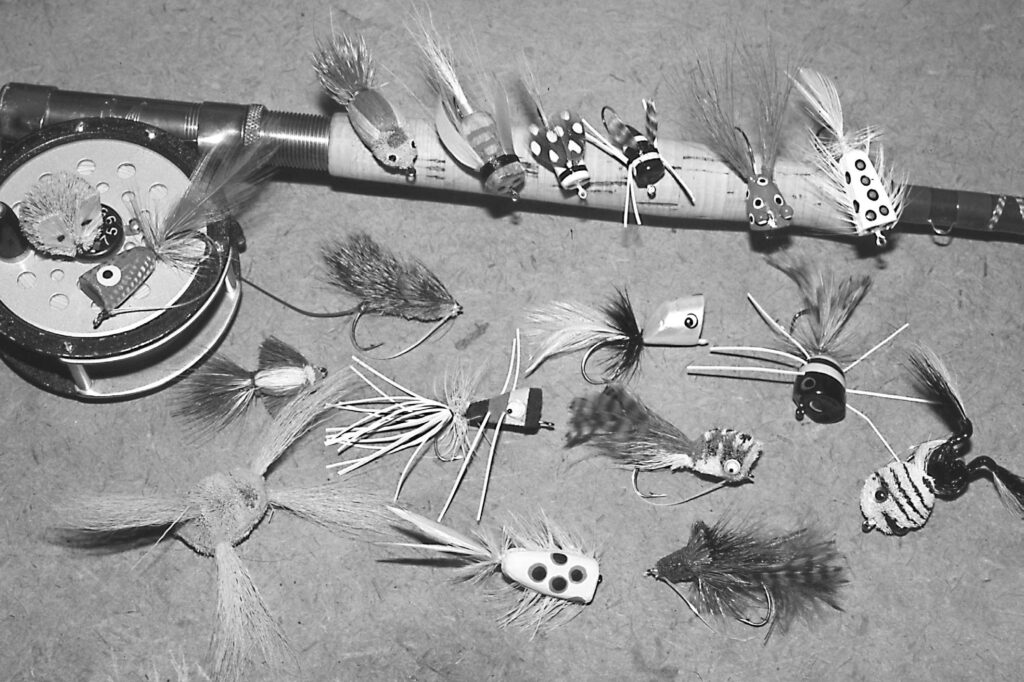
Perris has a two-fish, 15-inch minimum length limit for bass. This regulation was put in place to protect the trophy-quality spotted bass fishery that collapsed after the largemouth bass were illegally introduced. Several groups have lobbied the DFG to return the lake to the five-fish, 12-inch limit that’s the state standard, but so far, the Fish and Game Commission has said no. The 15-inch minimum protects bass until after at least one spawning, and combined with a growing catch-andrelease practice by the majority of bass anglers, it helps maintain the quality of the bass fishery.
You aren’t likely to catch a bass on a fly that’s the size of the lake record, although nothing is certain in this sport. What makes Perris so much fun for the fly angler is the abundance of bass at or just below the 15-inch minimum size limit. These you can catch all day long when conditions are right, and there are enough bass in the three-to-six-pound range to keep things very interesting. The knowledgeable bait-and-tackle boys catch bigger bass, though, and you always have a chance of catching a really big fish, too. Warm, overcast days in midspring are best for the larger bass.
The riprap-covered points and coves on the north side of the lake are favorites of mine. You don’t need waders or a float tube — just prowl the water’s edge, rock hopping and balancing on the hunks of granite and fan-casting the area. Most of the year, the water is clear, and you can see the granite chunks disappearing into the green depths for quite a distance. You won’t often spot the bass, but once in a while, a huge dark shadow will drift across your field of vision right at the limit of light penetration. It can make the hair stand up on the back of your neck.
The cove that holds the marina is a good place for both bass and big bluegills (also for huge redear sunfish, which many anglers cannot tell from bluegills). The management gets fussy at times about anyone casting near the back end of the cove, where the snack bar and tackle shop are located, but the presence of the docks and boats provides shade for bass. You can’t fish from the docks, but you can fish at them from the shore.
It’s instructive to walk the docks with polarized glasses and view lunkers finning quietly in the shade of a boat. In addition to bass the size of your thigh loafing around in the shadows, you’ll see Floridastrain bluegills the size of a dinner plate. Early in the morning and again in the evening, these larger fish will move out to work the riprap and chase schools of smaller fish in the open. They are susceptible at such times to small streamers and silver or white poppers.
Sinking or neutral-density fly lines are used a lot, but the northern and eastern shorelines are where floating bass-taper lines come into their own. During bright daylight, you’ll probably need to get a fly down several feet to do much good, but early and late and on overcast days, a floating line and surface flies are just fine. One thing about Perris is that the area is subject to many cloudy, foggy days in the spring and early summer. This intrusion of the coastal marine layer into the Inland Empire is known as “June gloom,” and often the fog doesn’t burn away until late morning — ideal conditions if you would like to pursue bass with fly gear.
If it is open, the best place to park is the lot near the newly-built launch ramp for personal watercraft. It’s as far to the northeast as you can get with a vehicle. You can park in that area and cross the ramp to get on the bike path that heads around the upper end of the lake. There’s one dead spot where there doesn’t seem to be any fish, but a little way along, the angling picks up again, and the fishing is good all the way around the northeastern end to Bernasconi Beach.
Bernasconi Beach is the third entrance to Lake Perris State Park. It has picnic areas and a fair amount of parking, and gives anglers quick access to the southeastern side and to some of the best structure and brushy banks on the lake. This entrance is unattended, and you must either buy your day-use pass at one of the other two entrances or fill out the little envelope and deposit your $10.00 fee in the metal “iron ranger” box at the gate.
Fly patterns for Perris largemouths are about what you would expect. Nonselective when they are feeding, bass rarely ask for much in the way of hatch matching. I’ve caught bass on all sorts of homedesigned streamers and bottom-bouncing jig-fly designs. Lots of movement from marabou and other soft hackles seems best. I also like flies with lots of rubber legs, and so do the bass. Woolly Buggers from size 12 to size 1/0 have worked consistently. Try black or combinations of green, rusty red, and browns — crayfish colors. Crayfish patterns of all shapes and sizes work very well. When the bass are relating to the surface, frog colors in deerhair and cork poppers work very well, as do silver and white streamers, which look like shad.
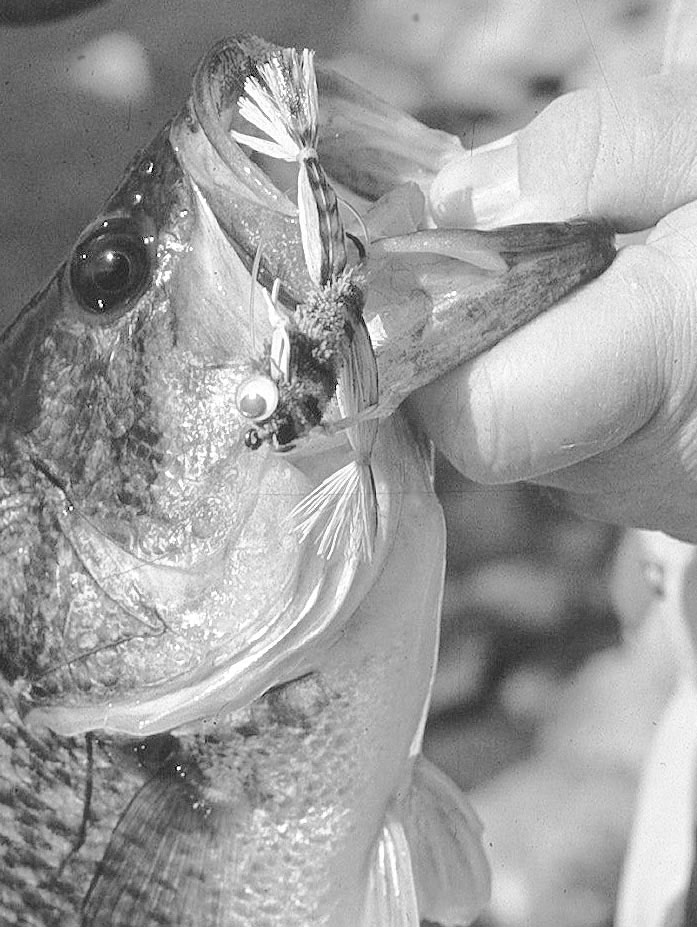
Dave Leak, who guides fly anglers on Diamond Valley Reservoir and Lake Skinner for big striped bass and largemouths, also fishes Lake Perris. “I like it a lot,” Dave told me. “When conditions are right, the east side off Bernasconi Beach is a good place to fish. Another good spot that seems to be a bedding area in the spring is the side of Alessandro Island that faces the marina. Despite the water being down, there’s still a lot of gently sloping shallows, and you’ll get good top-water action.
“What is the most fun is what I call the frog and rat bite,” Dave laughed. “In the spring and again in the fall when conditions are right, the bass just go nuts for surface poppers and stuff like a hair mouse. That good top-water bite can start in March and still be going at times as late as June on overcast days.”
This spring brings the promise of another good fishing year for warmwater species. Lake Perris certainly belongs on your list of places to visit, and for my money, it ought to be near the top of your list. Despite drawdowns and budget woes, it’s at the top of mine.
If You Go . . .
The Lake Perris state recreation area is located in Moreno Valley, near Riverside, some 70 miles east of Los Angeles and 80 miles north of San Diego.
It has three entrances. The north and south gates are normally manned, and there’s an unmanned pay-envelope gate at Bernasconi Beach on the southeast side of the lake. To reach Perris from Los Angeles, take the Pomona Freeway (Highway 60) to Moreno Beach Drive, then go south to the north entrance gate or turn south on Interstate 215 to the Ramona Expressway, then turn east. It’s about 3 miles to the south entrance from there.
Due to budget shortfalls, many state parks are closed a couple of days each week during the winter months. At Lake Perris, the closure days are currently Tuesday and Wednesday. The lake is open from 6:00 A.M. to 8:00 P.M., Thursday through Monday. This situation will continue until April 30, 2012, when Perris will be open seven days a week for the summer months. You can get up-to-date information on this and other subjects by going to http://www.parks.ca.gov/?page_id=651. Campsites are available for tents, RVs, and trailers, some with hookups. Check http://www.parks.ca.gov/?page_id=22122 or call (800) 444-7275 for current prices. For additional information, call the park office at (951) 940-5600. By May, average daily air and water temperatures are rising. The area can be quite hot during the summer and can be cold and frequently windy in the winter. Some mornings can be chilly, and thick fog is not unheard of.
The day-use fee is $10.00 per car. Boat launching costs an additional $8.00 per vessel. You can also purchase annual passes. Float tubes, canoes, and kayaks are not considered vessels and may launch free, but they must pass the inspection for quagga mussels, as must all boats.
Lake Perris has a full-service marina with boat rentals and excellent launch ramps. There also are bait-and-tackle and snack-bar facilities. Fly tackle is not available at the lake, so you’ll need to bring everything you think you’ll need.
Lake Perris is also known as a fantastic bluegill lake. Florida-strain bluegills were stocked several years ago, and the lake regularly produces bluegills in the range of two to two and a half pounds, with a few over the three-pound mark. Trout are stocked in the winter and provide fly anglers with some action. Many of the trout hold over through the summer. For information on current fishing conditions at Lake Perris, call the Marina at (951) 657-2179. Fish-n-Map, 8535 W. 79th Avenue, Arvada, CO 80005, has a topographical map for anglers that also includes Lake Skinner and Lake Silverwood.
Richard Alden Bean



